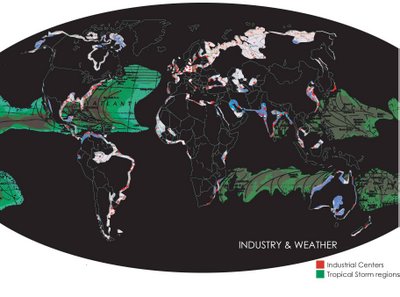


The effect by such causes varies in degree according to the country or region. The illustration belows shows the areas that are more affected by one cause than another. If the sea continues to rise at its current rate, a considerable portion of the earth's land mass will be lost. The images below begin to show the receding coastline as well as the land that will be lost or currently endangered.

 These areas face the danger of becoming extinct or lost to the sea. However, they contain valuable economies, products, and cultures. Their loss will result in economic loss internationally as well as directly affecting and displacing their people. Further analysis closely looks at the population density, the GDP as an economic factor, and centers of industry. Certain areas will be vacated naturally due to migration and therefore will not suffer as great of a loss. The mapping of tropical storms show the areas that are at the greatest risk of immediate effects.
These areas face the danger of becoming extinct or lost to the sea. However, they contain valuable economies, products, and cultures. Their loss will result in economic loss internationally as well as directly affecting and displacing their people. Further analysis closely looks at the population density, the GDP as an economic factor, and centers of industry. Certain areas will be vacated naturally due to migration and therefore will not suffer as great of a loss. The mapping of tropical storms show the areas that are at the greatest risk of immediate effects.




 The new world presents the result of a continued rise in sea levels if no action is taken. Based on the analysis above, several areas were determined to be at a greater risk than others due to a number of contributing factors. These include the number of people affected, the level at which the economy will be affected, the threat of tropical storms, current migration, and the possible loss of industrial centers. The areas with the most contributing factors include the east coast of the United States, a region in northern Europe, the southeastern coast of China, and the east coast region of India. These list includes only a small number of the areas impacted. The challenge becomes to design constructs, whether it be housing or mixed use, that embrace these atmosphere and work towards preventing the effects of global warming. Among other factors, it will be important to address the presence of greenhouse gases, the effect of heat and radiation, and potential and likely flooding. Can a megastructure include modules that will be moved with the sea? How will it address such issues?
The new world presents the result of a continued rise in sea levels if no action is taken. Based on the analysis above, several areas were determined to be at a greater risk than others due to a number of contributing factors. These include the number of people affected, the level at which the economy will be affected, the threat of tropical storms, current migration, and the possible loss of industrial centers. The areas with the most contributing factors include the east coast of the United States, a region in northern Europe, the southeastern coast of China, and the east coast region of India. These list includes only a small number of the areas impacted. The challenge becomes to design constructs, whether it be housing or mixed use, that embrace these atmosphere and work towards preventing the effects of global warming. Among other factors, it will be important to address the presence of greenhouse gases, the effect of heat and radiation, and potential and likely flooding. Can a megastructure include modules that will be moved with the sea? How will it address such issues?

3 comments:
Your exploration is very informative, and a little too real for those of us in Charleston! How does this mapping "reveal hidden potential"? Would a mega-structure that moves with the ocean create a refuge? Migration from those high risk areas might also be mapped to reveal potential.
Jill Hazel: Mid-Review Crit: November 9, 2006:
Peter Laurence, Lecturer in Architecture, Clemson University:
1. Information Design
1.1. Megastructure Level—Product vs. Process: Without suggesting that process is not critical, it is difficult to distinguish hierarchy within the blog. What are the raw data investigations? What are the intermediary steps? What are the final/mid-review parts of the project? The experience is akin to visiting your studio desk in Lee Hall, with all the work of the semester on it, and having to pick out the studies, final project, etc. It can be done, but with more effort and potential of misunderstanding. If the Friday, Nov. 3 post was the mid-review post, it should be labeled as such. Similarly, it would be good to review your objectives (the assignment) at the outset.
1.2. Intermediary Level--Labels: What information should the visitor focus on? The link to your final assignment on Prof. Real's email is not working, so I am reviewing based on your last post. It would be good, for the purpose of context making, to clarify which post represents work completed for mid-review.
1.3. Artifact Level--Numbers or keys: Numbering or keying your images in the blog or in the images themselves would facilitate discussion of images and allow the visitor can follow along.
2. Content/Project
2.1. Image Styles & Types—Do these have significance? The first 5 images have their own style; the next seven have different styles—are these differences significant. Do they represent the different between data and analysis?
2.2. Image 1: C02 emissions: A well presented and clear representation.
2.3. Images 2 & 3—C02 + Temp: What is the difference between these? They both have the same data. Why add these two datas together? I don’t understand how emissions and temp can be aggregated.
2.4. Image 5: Also effective and generally clear. However it is unclear whether this is extracted from Image 3. You follow with an image of Population Density. It would effective if height/extent of endangered land was shown by population density affected; another with land value or some economic data affected; etc.
2.5. Other images: What do data like migration have to do with any of your analyses?
2.6. Second to last image: You caption the New World image suggesting that it is important. How does it compare to Image 5?
3. Project/Proposal
3.1. Towards an Architecture: You only talk a proposal in the last and third to last sentences of the post. This should be a separate section and perhaps be considered in greater depth by this time in the study.
3.2. Housing or Mixed-Use “Constructs”: You seem to be suggesting sustainable architecture as a solution. I’m not sure why you use the word “constructs,” but if the point of your project is to make an argument for sustainable building, then you should be clear about that. I believe that you have supported such an argument, although you have not elaborated such an argument.
3.3. Megastructures: This is a very different proposal than above. It is also not as readily justifiable. There is no a priori agreement that a “megastructure,” whatever that might be, is the answer to the global problems that you have identified.
3.4. Toward a proposal: I would suggest keeping your ultimate proposal in proportion to your analysis. You have identified global issues and I don’t think the old (pre-global, Corbusian or Metabolist) notion of megastructures (or a traditionally conceived architectural project) is adequate. Proposing a whole new type of architecture, ie sustainable architecture, is a proposal of a different and, if globally embraced, perhaps somewhat effective scale. Of course, this is already being done based on data analyses similar to yours.
PL
jill,
because reviewers have left their email, i would encourage you to engage in a dialogue with them, asserting or clarifying your work based on their questions. you may email them, if they left contact information and redirect them to the blog post, after leaving your own responses to their comments in comments section of the posts.
it may be benificial to engage reviewers in more current developments in your project, since you do address some of the questions posed by Peter Laurence in your most recent entries.
Post a Comment